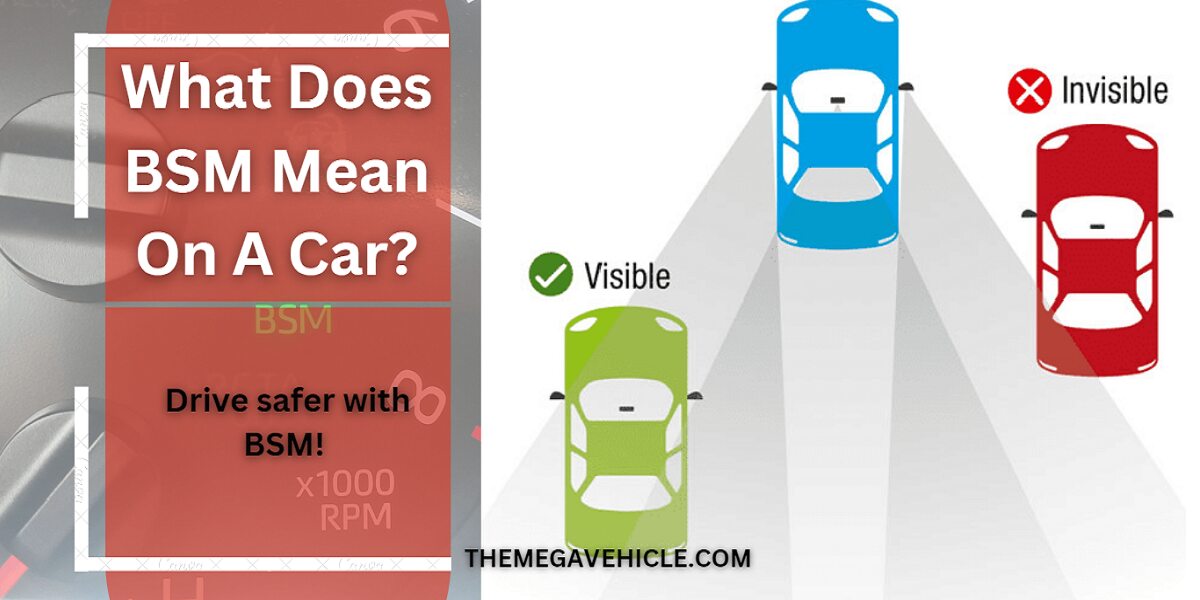What Does BSM Mean On A Car?

Have you ever spotted a small, enigmatic light on your dashboard or side mirrors bearing the inscription “BSM”? Although seemingly insignificant, this acronym holds immense importance for your driving safety and awareness. Today, we’ll embark on a journey to demystify the world of BSM, uncovering its true meaning and exploring its crucial role in enhancing your driving experience.
What Does BSM Stand For?
The cryptic acronym BSM stands for Blind Spot Monitoring. This innovative technology acts as your car’s watchful eye, constantly scanning for vehicles lurking in those elusive areas known as “blind spots.” These hidden zones typically reside just beyond the reach of your side mirrors and rearview mirror, posing potential threats when changing lanes or merging into traffic.
How Does BSM Work Its Magic?
Blind Spot Monitoring (BSM) has become a cornerstone of modern car safety, empowering drivers with crucial awareness and preventing potential accidents. However, navigating the diverse world of BSM systems can feel like venturing through a technological maze. To help you find your way, let’s dive deep into the two main types of BSM:
1. Radar-based BSM
Imagine tiny sentinels stationed on your car’s rear bumper or side mirrors. These are radar sensors, constantly emitting waves that bounce off nearby vehicles and return, revealing their position and relative speed. When an unsuspecting vehicle ventures into your blind spot, this radar network instantly springs into action, triggering a visual or audible alert, typically a light on your side mirror and sometimes even a beep or chime.
Advantages:
- Extended range: Radar-based BSM systems possess a longer detection range compared to camera-based systems, extending their watchful eye up to 3 meters from your car.
- Resilient to the elements: Rain, snow, or fog? No problem! Radar waves remain unfazed by these environmental factors, ensuring consistent performance in diverse weather conditions.
- Cost-effective: Radar-based systems generally offer a more affordable option compared to their camera counterparts.
Disadvantages:
- Size matters: Unfortunately, the larger size of radar sensors can sometimes detract from the aesthetics of your car.
- Accuracy concerns: Differentiating between stationary objects and moving vehicles can pose a challenge for radar waves, leading to the occasional false alarm.
- Limited vision: These systems are only capable of detecting objects in motion, potentially overlooking stationary hazards lurking in your blind spot.
2. Camera-based BSM
Picture tiny cameras strategically placed on your side mirrors or rear bumper. These watchful eyes capture continuous footage of your blind spots, providing a real-time view of what lies beyond your mirrors. Advanced image processing algorithms then analyze this footage, identifying any vehicles venturing into those unseen zones. Once a vehicle is detected, the system swiftly activates an alert similar to the radar-based system, keeping you informed about your immediate surroundings.
Advantages:
- Discreet design: Camera sensors are typically smaller and more discreet than their radar counterparts, blending seamlessly with your car’s aesthetic.
- Sharper vision: Image processing algorithms allow camera-based BSM to distinguish between vehicles and stationary objects, minimizing the risk of false alarms.
- Comprehensive awareness: This system doesn’t discriminate against stationary objects, providing additional safety benefits by detecting even static hazards in your blind spot.
Disadvantages:
- Limited range: While effective, camera-based BSM systems have a shorter detection range compared to the radar type, typically extending their reach up to 2 meters from your car.
- Environmental sensitivity: Fog, rain, or snow can impact the camera’s performance, reducing its accuracy in certain weather conditions.
- Higher cost: Compared to radar-based systems, camera-based BSM usually comes with a higher price tag.
3. Other BSM technologies
- Ultrasonic sensors: Emit sound waves and detect echoes, similar to radar but with a shorter range.
- LiDAR sensors: Emit laser pulses and measure the time it takes for them to bounce back, creating a 3D image of the surroundings.
Choosing the Right BSM for You
Navigating the world of BSM systems can be overwhelming. Ultimately, the best choice depends on your individual needs and priorities. If maximizing detection range and affordability are your top concerns, a radar-based system might be the perfect fit. However, if a sleeker design, enhanced accuracy, and awareness of stationary objects are your priorities, a camera-based system might be the ideal solution.
Remember:
- Regardless of the type you choose, BSM is a valuable safety tool, but it’s not a substitute for safe driving practices.
- Always utilize your mirrors and perform blind spot checks before changing lanes or merging.
- Consult your car’s owner’s manual for specific details regarding your BSM system’s features and functionalities.
By understanding the diverse world of BSM and choosing the system that best suits your needs, you can unlock a new level of awareness and safety on the road. So, embark on your journey with BSM as your guide and navigate the traffic with confidence, knowing that you have a safety net in place.
Exploring Additional BSM Features
The world of BSM extends beyond simply detecting vehicles in your blind spot. Various advanced features further enhance your driving experience and safety:
1. Blind Spot Information Systems (BLIS): This system takes BSM to the next level, not only notifying you of vehicles in your blind spot but also providing information about their speed and direction. This additional data empowers you to make even more informed decisions behind the wheel.
2. Rear Cross Traffic Alert (RCTA): Reversing out of a parking spot or driveway can be nerve-wracking, especially with limited visibility. RCTA comes to the rescue by detecting approaching vehicles from the sides when you’re reversing, alerting you through visual or audible warnings.
3. Lane Change Assist (LCA): This system acts as your guardian angel when changing lanes. It actively prevents you from changing lanes if a vehicle occupies your blind spot, offering an extra layer of protection and preventing potential collisions.
Benefits of Blind Spot Monitoring (BSM)
Blind Spot Monitoring (BSM) has rapidly become a sought-after feature in modern vehicles, and with good reason. This technology offers a multitude of benefits that can significantly enhance your driving experience and contribute to a safer environment on the road. Let’s delve into the key advantages of having a BSM system in your car:
I. Reduced Risk of Accidents and Collisions
BSM plays a crucial role in preventing accidents by alerting you to vehicles present in your blind spots, those areas typically outside your rearview and side mirrors. This heightened awareness allows you to make informed decisions when changing lanes, merging into traffic, or navigating challenging situations. By minimizing the risk of overlooking a vehicle in your blind spot, BSM directly contributes to safer driving and reduces the potential for accidents.
II. Enhanced Situational Awareness
Navigating complex traffic environments requires constant vigilance and a clear understanding of your surroundings. BSM provides invaluable assistance by actively monitoring your blind spots and notifying you of any approaching vehicles. This additional layer of awareness empowers you to anticipate potential hazards and react accordingly, ensuring a smoother and more confident driving experience.
III. Increased Driver Confidence
Knowing that your car has your back by actively monitoring your blind spots can significantly boost your confidence and comfort behind the wheel. This is especially true for novice drivers or those who navigate unfamiliar roads or challenging traffic conditions. BSM alleviates the anxiety associated with blind spots, allowing you to focus on the road ahead and make informed decisions with greater certainty.
IV. Improved Safety for Vulnerable Road Users
BSM plays a vital role in protecting vulnerable road users like cyclists and motorcyclists, who are often difficult to spot in traffic. By alerting you to their presence in your blind spots, BSM provides ample time to adjust your driving behavior and ensure their safety. This contributes to a more inclusive and responsible driving environment where all road users are protected.
V. Reduced Stress and Fatigue
Constantly checking your blind spots can be tiring, especially during long journeys or in congested traffic. BSM alleviates this stress by automatically monitoring your blind spots, allowing you to focus solely on the road ahead and reduce fatigue. This results in a more relaxed and enjoyable driving experience, improving your overall well-being and safety.
VI. Increased Insurance Discounts
Many insurance companies offer discounts to drivers with BSM systems, recognizing their significant contribution to reducing accidents and minimizing risk. This financial incentive further emphasizes the value of having BSM in your car.
VII. Improved Resale Value
As BSM becomes increasingly standard in modern vehicles, it is quickly becoming a highly sought-after feature by potential buyers. Having BSM installed in your car can potentially increase its resale value, making it a worthwhile investment.
The benefits of having a BSM system in your car are undeniable. This technology enhances safety, promotes awareness, boosts confidence, and contributes to a more relaxed and enjoyable driving experience. With its numerous advantages and growing popularity, BSM is undoubtedly a valuable addition to any vehicle.
Limitations Of BSM and How to Overcome Them
While Blind Spot Monitoring (BSM) offers incredible benefits for enhanced safety and awareness on the road, it’s not without limitations. Understanding these limitations is crucial to utilizing BSM effectively and ensuring your safety.
I. Limited Range
BSM systems typically detect vehicles within a specific range, usually around 3 meters from your car. While this provides a valuable buffer for changing lanes and merging, it’s essential to remember that BSM doesn’t offer a complete 360-degree view. Vehicles outside the detection range remain invisible to the system, emphasizing the importance of always utilizing your mirrors and performing blind spot checks.
II. Environmental Impact
Fog, rain, or snow can significantly impact the accuracy of BSM. These environmental factors can interfere with sensor functionality, potentially leading to missed detections or delayed alerts. Remember to be extra cautious when driving in adverse weather conditions, relying less on BSM and more on traditional blind spot checks.
III. False Alarms
No technology is perfect, and BSM is no exception. Occasionally, the system might trigger false alarms, often due to stationary objects like parked cars or guardrails reflecting signals and mimicking moving vehicles. While these false alarms can be annoying, they serve as a reminder to remain vigilant and not solely rely on BSM for blind spot awareness.
IV. Additional Limitations
- Blind Spot Size: BSM systems have blind spots themselves, particularly in areas near the rear bumper corners. Be aware of these “blind spot blind spots” and adjust your reliance on BSM accordingly.
- System Malfunctions: Like any technology, BSM systems can malfunction or experience technical issues. It’s crucial to be aware of any warning lights or messages indicating potential problems and address them promptly.
- Over-reliance: BSM should be seen as a supplemental safety tool, not a substitute for safe driving practices. Always prioritize using your mirrors, performing blind spot checks, and maintaining a safe distance from other vehicles.
V. Overcoming the Limitations
While limitations exist, you can easily overcome them by taking these steps:
- Maintain awareness: Never solely rely on BSM. Continuously scan your mirrors and perform blind spot checks before changing lanes or merging.
- Be cautious in bad weather: During fog, rain, or snow, increase your vigilance and reduce reliance on BSM.
- Stay informed: Familiarize yourself with your specific BSM system’s limitations and range of detection.
- Regular maintenance: Ensure your BSM sensors are clean and free of obstructions for optimal performance.
- Don’t ignore warnings: Address any warning lights or messages related to BSM malfunction promptly.
BSM is a powerful tool for enhancing safety and awareness on the road. However, understanding its limitations is crucial to maximizing its effectiveness and ensuring your safety. By remaining vigilant, adapting to environmental conditions, and employing traditional blind spot checks, you can overcome these limitations and leverage BSM’s full potential for a safer and more confident driving experience
Troubleshooting Common Issues and Maintaining Optimal Performance
Blind Spot Monitoring (BSM) systems have revolutionized the way we drive, enhancing awareness and preventing accidents. However, even the most sophisticated technology can encounter occasional hiccups. Recognizing and resolving these common BSM issues is crucial to maintaining optimal performance and ensuring your safety on the road.
Unmasking the Culprits Behind BSM Anomalies:
Here’s a closer look at some of the most frequent BSM problems and how to tackle them:
1. False Alarms:
- Causes: Environmental factors like rain, snow, or dust can confuse the sensors. Similarly, dirt or debris clinging to the sensors can also trigger false alarms. In some cases, miscalibration of the system might be the culprit.
- Solutions: Begin by cleaning the sensors and surrounding areas with a soft cloth. Check for any objects obstructing the sensors’ view and remove them. Recalibrate the system according to your car’s owner’s manual. If the problem persists, consult a professional for further diagnosis and potential repair.
2. Inconsistent Detection:
- Causes: Sometimes, misalignment of the sensors can lead to inconsistent detection of vehicles in your blind spots. System malfunctions or software bugs might also be at play.
- Solutions: If your BSM system seems to be missing vehicles occasionally, try recalibrating it. Additionally, check if any software updates are available for your car’s BSM system and install them if necessary. If the problem persists, seek professional assistance for diagnosis and repair.
3. System Not Working:
- Causes: In some cases, the problem might be more serious, involving sensor damage, faulty wiring, or other electrical issues within the BSM system.
- Solutions: Carefully inspect the sensors for any visible damage. Check the wiring for fraying or breaks. If you suspect a more complex issue, it’s best to consult a professional for diagnosis and repair.
4. Dim or Flickering Indicator Lights:
- Causes: Faulty bulbs, loose connections, or a system malfunction can cause the BSM indicator lights to dim or flicker.
- Solutions: Check the bulbs for any burns or damage and replace them if necessary. Additionally, look for loose connections within the system and tighten them as needed. If the problem persists, consult a professional for further diagnosis and repair.
5. Delayed or Missing Alerts:
- Causes: Sensor miscalibration, system overload in dense traffic, or software bugs can contribute to delayed or missing alerts from your BSM system.
- Solutions: Recalibrate your BSM system to ensure proper sensor alignment. If you’re driving in heavy traffic, be aware that the system might become overloaded and miss certain vehicles. Consider practicing caution and relying less on BSM in these situations. Finally, update the software to the latest version if available, as this might address any underlying bugs.
Maintaining a Healthy BSM
To keep your BSM system functioning optimally and ensure its longevity, consider these simple maintenance tips:
- Regular cleaning: Regularly clean the sensors and surrounding areas with a soft cloth to remove dust, dirt, or debris that might obstruct their view.
- Parking awareness: Avoid parking near objects that could block the sensors’ view of your blind spots.
- Weather caution: Be extra cautious when driving in harsh weather conditions like rain, snow, or fog, as these can affect sensor performance.
- Software updates: Keep your BSM system’s software updated to the latest version whenever available.
- Consult the manual: Refer to your car’s owner’s manual for specific maintenance instructions and troubleshooting tips tailored to your BSM system.
The Bottom Line: Why BSM is More Than Just a Trend
In today’s dynamic and ever-evolving driving landscape, where roads become increasingly congested and complex, advanced safety features like Blind Spot Monitoring (BSM) have transformed from mere convenience to a crucial necessity. This technology has transcended its initial introduction to become a vital tool, empowering drivers with heightened awareness, preventing potential accidents, and ultimately fostering a safer driving environment for everyone on the road.
Investing in a vehicle equipped with BSM is not just an investment in your own safety, but a proactive step towards protecting those around you. While technology is constantly evolving, the core benefits of BSM remain undeniable. It provides a valuable safety net that extends beyond your mirrors, offering crucial blind spot awareness, allowing for informed decision-making, and ultimately contributing to a safer and more enjoyable driving experience for all road users.
As the adoption of BSM technology continues to rise, it becomes increasingly evident that this innovative feature is more than just a passing trend, but a vital step towards a future of safer and more responsible driving. By embracing this technology and its inherent benefits, we can collectively work towards creating a safer and more sustainable transportation landscape for everyone.
Here are some additional points to consider:
- BSM is not a substitute for safe driving practices: While it provides an extra layer of protection, it is crucial to remember that BSM is a supplemental tool. Always prioritize safe driving practices like maintaining a safe following distance, utilizing your mirrors, and performing blind spot checks before changing lanes.
- The future of BSM: As technology continues to evolve, we can expect even more advanced BSM systems with features like enhanced detection range, improved accuracy in adverse weather conditions, and integration with other driver-assistance systems.
- The impact of BSM on insurance premiums: Many insurance companies offer reduced premiums to drivers with BSM-equipped vehicles, acknowledging the significant role this technology plays in reducing accidents and minimizing risk.
In conclusion, embracing BSM technology is not only a wise decision for your own safety but also a positive step towards a future of safer and more responsible driving for everyone. By making informed choices and prioritizing advanced safety features like BSM, we can collectively work towards creating a transportation landscape where every journey is a safe and enjoyable one.






